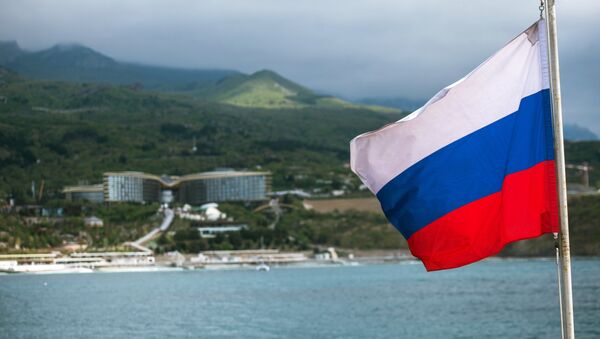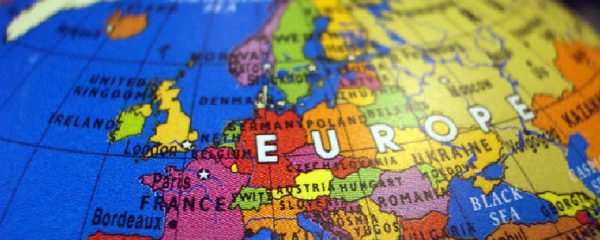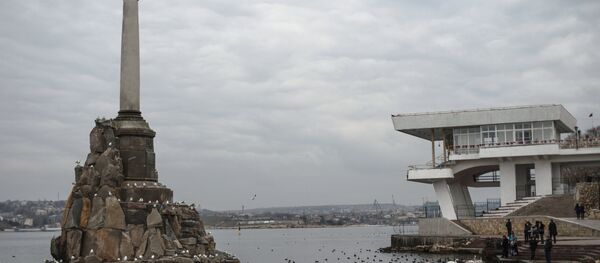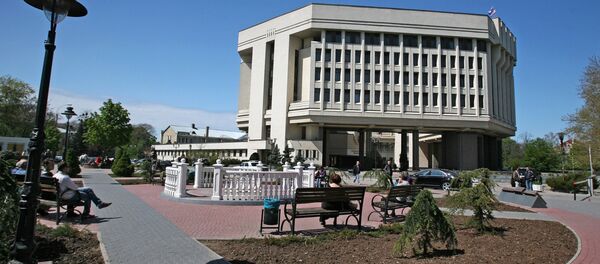Ever since in 1954 they were arbitrarily transferred from Russia to Ukraine in what the British Foreign Office called an “administrative fiat” by the Communist leader Khruschev, the Crimeans were denied the right to have their say on where they wanted to be. Under independent Ukraine, the autonomous status of Crimea with its distinct ethnic, linguistic and cultural identity was abolished and all Crimean efforts to reclaim it were suppressed by Kiev.
Brief Prehistory
The Crimeans were not consulted about the transfer and never accepted what some called a “virtual deportation” from Russia to Ukraine. In January 1991 they held a referendum in which over 87% voted for the restoration of the autonomous status and designation of Crimea as a signatory to the USSR Union Treaty. Ukraine’s parliament acquiesced and restored Crimea’s autonomy but omitted to confer on the republic the status of a party to the Union Treaty. This all happened before Ukraine declared its independence from the Soviet Union.
READ MORE: French Lawmaker Praises Crimea's 'Breakthrough' Since Reunification With Russia
In December 1991 a pan-Ukrainian referendum approved the declaration of Ukraine’s independence. However, the Crimeans were denied the Constitutional right to hold their own referendum on whether to leave the Soviet Union together with Ukraine or decide on their own course of action. Five months later, in May 1992 Crimea’s parliament adopted its own declaration of sovereignty, Constitution and introduced the post of President of the Republic. The move was seen by the British diplomats as “ending the legal status of Crimea as part of Ukraine”. The first, and last, President of Crimea, Yuri Meshkov was elected in January 1994 on a ticket of re-integration with Russia. A year later he was deposed by Kiev who also abolished the Crimean Constitution of 1992.
READ MORE: Saakashvili Claims Poroshenko Planned to Swap Crimea for NATO Membership

Every Map Tells the Same Story
The voting maps tell a very graphic story of the preferences of the Crimeans that remained unchanged from one election to another.
READ MORE: US House Passes Anti-Russian Bills In Bid to Ramp Up Pressure Against Moscow
In each election, the contest boiled down to a run-off between two candidates, one being perceived as pro-Western and the other as pro-Russian. The Crimeans, just like the people of Donbass, another distinct ethnic, linguistic and cultural region of Ukraine, invariably voted for the one who was perceived either as pro-Russian or at least as seeking better relations with Russia.
READ MORE: Google Informs Russian Duma Crimea Shown as Russian Region on Maps — Lawmaker
Presidential Election 1991
The first presidential election in independent Ukraine was held in December 1991. The incumbent head of Ukraine’s Parliament and its former Communist boss Leonid Kravchuck won hands down over the anti-Communist People’s Movement candidate Vyacheslav Chornovil. Kravchuk was supported by the ex-Communists and all those who saw independent Ukraine as a close neighbour to Russia. Chornovil was perceived as a nationalist who would damage relations with Russia.

This map shows the results of the Ukrainian presidential elections of 1991, when Leonid Kravchuk defeated Viacheslav Chornovil. The map elaborates on the map of the 1991 elections made by Vasyl` Babych.
The areas in orange show West Ukrainian regions where the nationalists won the vote in 1991. The blue coloured regions went to Kravchuk. Note the Donbass figures (Lugansk — 76.23%; Donetsk – 71.47%) are even higher than the Crimean with 56.68%. The pro-Soviet feelings were strongest in the ex-Soviet industrial heartland of Donbass.
Presidential Election 1994
However, by 1994 the industrial workers of East Ukraine got disillusioned with Kravchuk who did little to alleviate their plight in the face of a severe economic crisis. In December 1993 the Donbass miners began an indefinite strike which forced the parliament to call a snap presidential election in June 1994. Kravchuk was challenged by a former Soviet factory director and an ex-premier Leonid Kuchma, who said he would improve ties with Russia. He won.

READ MORE: UK and US Always Knew Crimea Wanted to Re-join Russia — Archives
This map shows the results of the second round of the Ukrainian presidential elections of 1994, when Leonid Kuchma defeated Leonid Kravchuk. The map elaborates on the map of the 1994 elections made by Vasyl` Babych.
Again, the orange colour symbolizes pro-Western, while the blue colour symbolizes pro-Russian preferences of the “two Ukraines”. Note the figures for Kuchma in Crimea (89.7%) and Sevastopol (91.98%)
“Orange Revolution” of 2004
The standoff between the “two Ukraines” came to a head in the presidential election of 2004. It was dubbed the “Orange Revolution” after the color of the scarves sported by the pro-Western activists during the protests against what they claimed was electoral fraud by Viktor Yanukovych, a candidate who was perceived as pro-Russian. He was declared the winner in November 2004.
Yanukovych’s victory triggered protests in Kiev’s central square, the Maidan, and interference by the EU and the US who refused to accept the result and demanded a re-run. Under pressure from a string of visiting Western leaders, Yanukovych agreed – and lost. The regional voting patterns remained unchanged but this time the pro-Western “Orange” candidate Viktor Yushchenko came out on top.
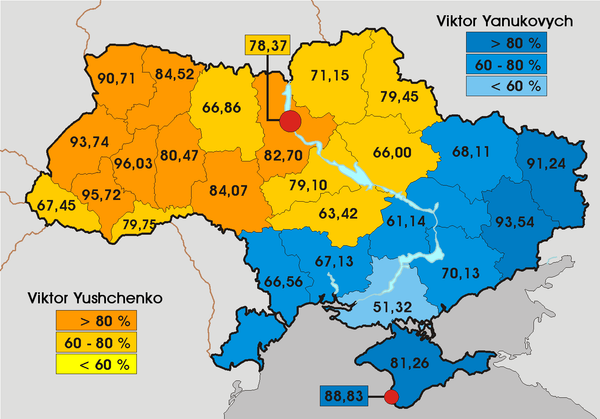
READ MORE: UN General Assembly Adopts Ukraine's Resolution on Russia's Crimea
The re-run in December 2004 was declared free and fair by the EU and the US. However, note the figures for the “pro-Russian” Yanukovych in Crimea (81.26%) and Sevastopol (88.83%). They are almost identical to the results that were declared “fraudulent” by the West only a month before. This time they were accepted as fair and legitimate.
“Orange” Wipeout 2010

Note the figures for the “pro-Russian” Yanukovych in Crimea (78.24%) and Sevastopol (84.35%). Also note the extremely high figures for Yanukovych in Lugansk (88.96%) and Donetsk (90.44%). The election was declared free and fair by the OSCE observer mission.
The Proof of the Pudding — Referendum 2014
READ MORE: Anonymous Hackers Expose UK Plans to Mine Sevastopol Days Before Crimea Vote
Given the figures from all presidential elections in Ukraine since 1991, the results of the Crimean referendum of 85.87% in Crimea and 93.62% in Sevastopol in favour of reunification with Russia should not come as a surprise. They are fully consistent with all previous internationally recognized voting patterns in Crimea and prove beyond doubt that the referendum of 16 March 2014 correctly and truthfully reflected the will of the Crimean people to reunite with Russia.
No wonder the British Foreign Office and the US State Department predicted back in 1994 that Ukraine would eventually split and that Crimea would look to Russia.
